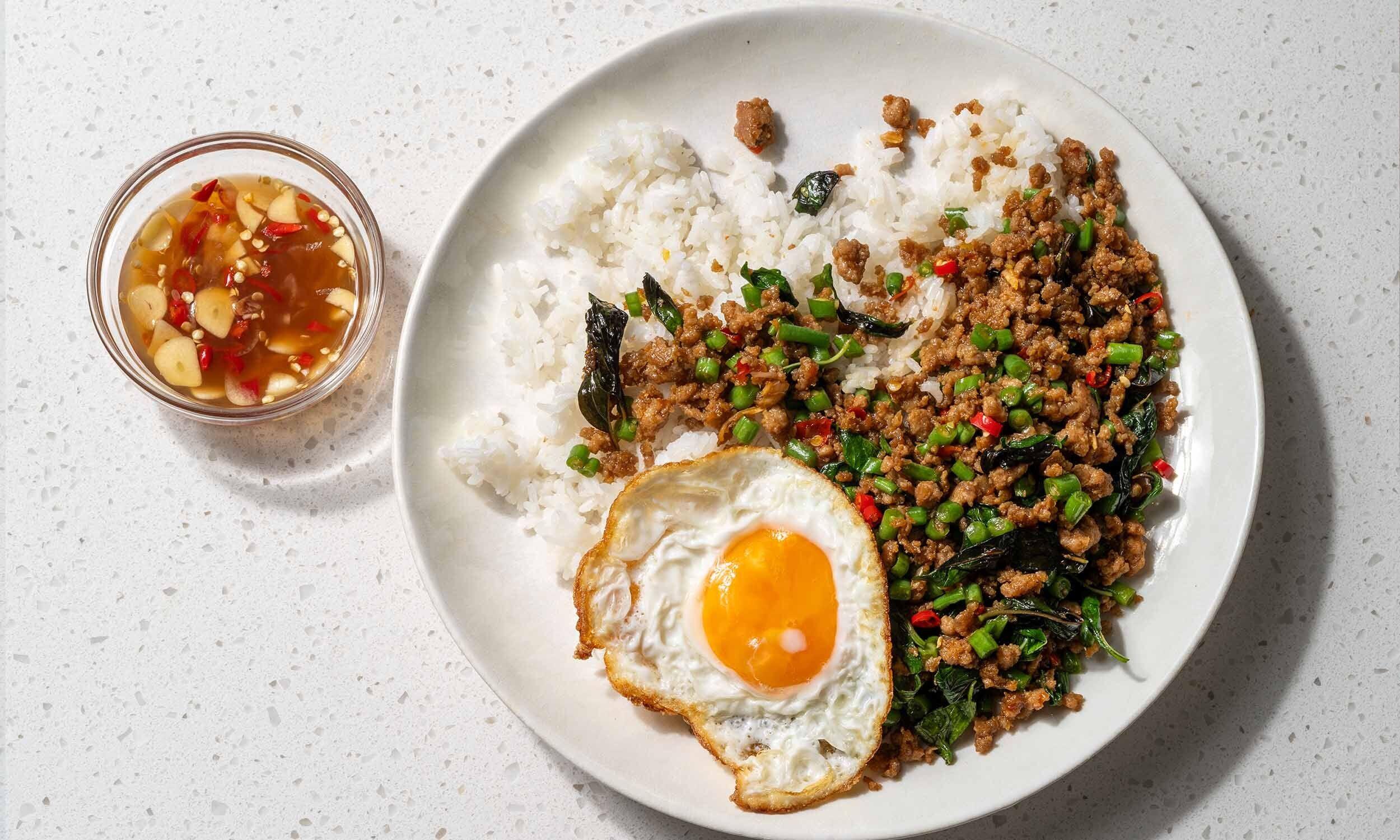The star of pad kra pao (พะแนงเนื้อ), possibly the most eaten dish in Thailand, isn’t the ground meat. It’s the holy basil or kaphrao, hence the dish’s name: “stir-fried holy basil”. It lends a peppery aroma to an already fragrant stir-fry of garlic, Thai chilies, fish sauce, and whatever giniling you have (we use pork). Just like the basil, a runny egg with crispy whites is a must.
Some versions of pad kra pao add crunchy long beans cut into small pieces. Controversial for purists, but we say extra veg is always good, especially when you're eating at home. It's fast, flavorful, and a lifesaver for busy weeknights.
What is holy basil?
Holy or hot basil, kaphrao in Thai, is a basil variety with a peppery flavor. This isn’t the delicate Italian basil you use in pesto. Holy basil is a tougher green, capable of withstanding more heat (like in a stir-fry!) without losing its flavor.
Where do I find holy basil?
Holy basil can be hard to find. If you’re lucky, you’ll find it packed and labeled as such in your local grocery. Or buy a holy basil plant for fresh leaves!
If you can’t find holy basil, try Thai basil—this purple-stemmed variety has a different but similarly assertive aroma. In a pinch, go use regular or sweet basil; it will still taste great.
What are Thai chilies?
Thai cuisine uses a lot of Thai chilies, also known as bird’s eye chilies. They’re small (about 1-2 inches), slender, and extremely hot, adding that signature kick to pad kra pow.
When unripe, Thai bird's eye chilies have a green color and an herby, vegetal flavor. As they ripen, the chilies slowly turn bright red, and start tasting brighter and almost fruit-like. Some recipes use both ripe red and unripe green chilies to layer those two flavor profiles.
What’s the difference between Thai and local Filipino chilies?
Local chilies, or siling labuyo, look a lot like Thai chilies: they’re both small, red, somewhat pointy. Vendors sometimes confuse the two, but they’re not the same. Scientifically, Thai chilies and siling labuyo are cultivars of two different species: Capsicum annuum and Capsicum frutescens, respectively.
Both chilies also have different heat levels. Thai chilies can vary wildly between 50,000 to 100,000 on the Scoville scale, while siling labuyo keeps a steady 80,000–100,000.
Are they interchangeable? For this recipe, yes. Use whatever red chilies you have. Depending on your spice tolerance, you may want to deseed them, or use less than called for.
Ingredients
Ingredients
- 3 Thai or local chilies, whole or deseeded
- 4 garlic cloves, peeled
- 2 ½ tbsp oyster sauce
- 1 tbsp fish sauce
- ½ tbsp light soy sauce
- 1 tsp sugar
- 300–350g ground pork
- 1 cup green beans, sliced to ½-inch pieces
- 1 cup loosely packed holy or Thai basil
- 2 whole eggs
Prepare aromatics: In a mortar and pestle, pound chilies and garlic cloves to a paste. Set aside.
Prepare sauce: In a small bowl, combine oyster sauce, fish sauce, light soy sauce, and sugar. Whisk to dissolve sugar. Set aside.
Cook pork: Heat a bit of oil in a skillet over medium heat. Add ground pork in a single layer. With the back of a spoon, break up the pork to form pea-sized crumbles. Cook until lightly golden brown. Move the pork aside and add the chili-garlic paste right onto the skillet. Cook paste until fragrant, about 1 minute. Add sauce and a little less than ¼ cup water. Continue to cook until the liquid evaporates and the meat becomes saucier.
Add green beans and basil: Add green beans and cook, stirring it into the pork, 1 minute. Remove skillet from heat and stir in basil leaves, which will wilt from the residual heat. Transfer to a serving plate.
Cook eggs: Heat a separate pan (or wipe the one you just used clean) over medium heat. Add about 1 tbsp neutral oil. Once hot, crack an egg into the oil and cook to a crispy sunny side up. Remove from heat. Repeat with remaining egg.
Serve: Serve pad kra pao hot with crispy eggs and steamed rice.
